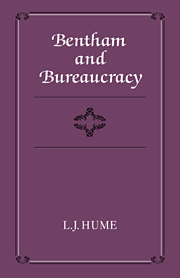Book contents
- Frontmatter
- Contents
- Preface
- Acknowledgements
- List of Abbreviations
- 1 Introduction
- 2 Government in eighteenth-century thought
- 3 The foundations of Bentham's thought: the Comment, the Fragment, the Introduction and Of Laws in General
- 4 Further explorations in jurisprudence
- 5 From principles to practice: the Panopticon and its companions
- 6 From the Panopticon to the Constitutional Code
- 7 The Constitutional Code and Bentham's theory of government
- 8 Conclusion
- Notes
- Bibliography
- Index
- Cambridge Studies in the History and Theory of Politics
5 - From principles to practice: the Panopticon and its companions
Published online by Cambridge University Press: 18 November 2009
- Frontmatter
- Contents
- Preface
- Acknowledgements
- List of Abbreviations
- 1 Introduction
- 2 Government in eighteenth-century thought
- 3 The foundations of Bentham's thought: the Comment, the Fragment, the Introduction and Of Laws in General
- 4 Further explorations in jurisprudence
- 5 From principles to practice: the Panopticon and its companions
- 6 From the Panopticon to the Constitutional Code
- 7 The Constitutional Code and Bentham's theory of government
- 8 Conclusion
- Notes
- Bibliography
- Index
- Cambridge Studies in the History and Theory of Politics
Summary
The chronological division between the two different kinds of speculation is marked roughly by Bentham's return to England from Russia in the winter of 1787–88. The change was not immediate or absolute. He did not immediately give up his work on the principles of jurisprudence, and he took it up again from time to time in the 1790s, possibly in order to help Dumont in the preparation of the Traités de législation. But after 1789 he was occupied mainly in studies of policies and institutions, above all in his work on the Panopticon. The shift in the pattern of his interests was in part the consequence of what he had done in Russia, but in part the consequence of a mass of other events; both public events such as the French Revolution, and events occurring in his own life or within the boundaries of his family. It made the 1790s the period in which he advanced most rapidly towards the detailed contents of the Constitutional Code.
The first edition of the Defence of Usury had been published by the time Bentham got back to England, and his draft of the first Panopticon essay was then also complete. The modest but definite success of the former work encouraged him to think of a second edition of it, and this in turn led him to raise new economic issues in his own mind. He was eventually able to find time to take these up, and to be drawn into the consideration of important problems in the field of money and banking as well as into attempts to draft elementary outlines of (or introductions to) political economy.
- Type
- Chapter
- Information
- Bentham and Bureaucracy , pp. 110 - 164Publisher: Cambridge University PressPrint publication year: 1981

